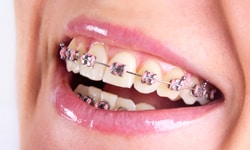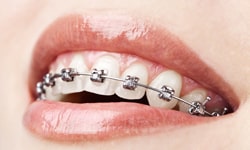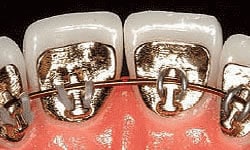Types of Braces
Types of Braces
Looks. Comfort. Speed.
Choosing the right type of braces is important for several reasons. Firstly, different types of braces have different treatment times, with some taking longer than others to achieve the desired results. Secondly, different types of braces may require different levels of maintenance and care, which may be a consideration for individuals with busy schedules or who prefer low-maintenance options.
Another important factor to consider when choosing braces is comfort. Some types of braces can cause discomfort or irritation, particularly in the initial stages of treatment. It is important to discuss any concerns with an orthodontist to determine the best option for the individual’s needs and comfort level.
The aesthetic aspect is also important to consider, as some types of braces are more discreet or invisible than others. Individuals who are concerned about the appearance of braces may prefer options such as clear aligners or lingual braces, which are attached to the back of the teeth and are not visible from the front.
Ultimately, the decision about which type of braces to choose should be made in consultation with an orthodontist, who can assess individual needs and provide guidance on the best option for achieving the desired results.
Image by wayhomestudio on Freepik
Traditional Metal Braces
Traditional metal braces are a type of orthodontic treatment that use metal brackets and wires to gradually move teeth into the desired position. They are the most common type of braces and have been used for many years. Traditional metal braces are often preferred for more complex orthodontic cases and may require more maintenance and care than other types of braces.

Self-ligating braces
Self-ligating braces are orthodontic appliances that use a specialized clip instead of elastic bands to hold the archwire in place. This clip allows for faster and more efficient tooth movement, as well as fewer appointments and less discomfort for the patient. Self-ligating braces come in both metal and clear ceramic options.

Clear (Ceramic) Braces
Clear ceramic braces are orthodontic appliances that use clear or tooth-colored brackets instead of metal ones. The brackets are made from a strong ceramic material that is less visible on the teeth, making them a more aesthetic option compared to traditional metal braces. Clear ceramic braces are a good option for those who want to straighten their teeth but are self-conscious about the appearance of traditional braces.

Clear Aligners
Clear aligners are orthodontic devices that are used to straighten teeth without the use of brackets or wires. They are custom-made, clear plastic trays that are worn over the teeth to gradually move them into the desired position. Clear aligners are removable and virtually invisible, making them a popular option for adults and teens who want a more discreet way to improve their smile.

Lingual Braces
Lingual braces are an orthodontic treatment option that use brackets and wires attached to the back of the teeth, making them virtually invisible from the front. They are custom-made to fit the individual’s teeth and can be used to correct a wide range of orthodontic issues. Lingual braces are a good option for people who want to improve their smile but do not want the braces to be visible.


